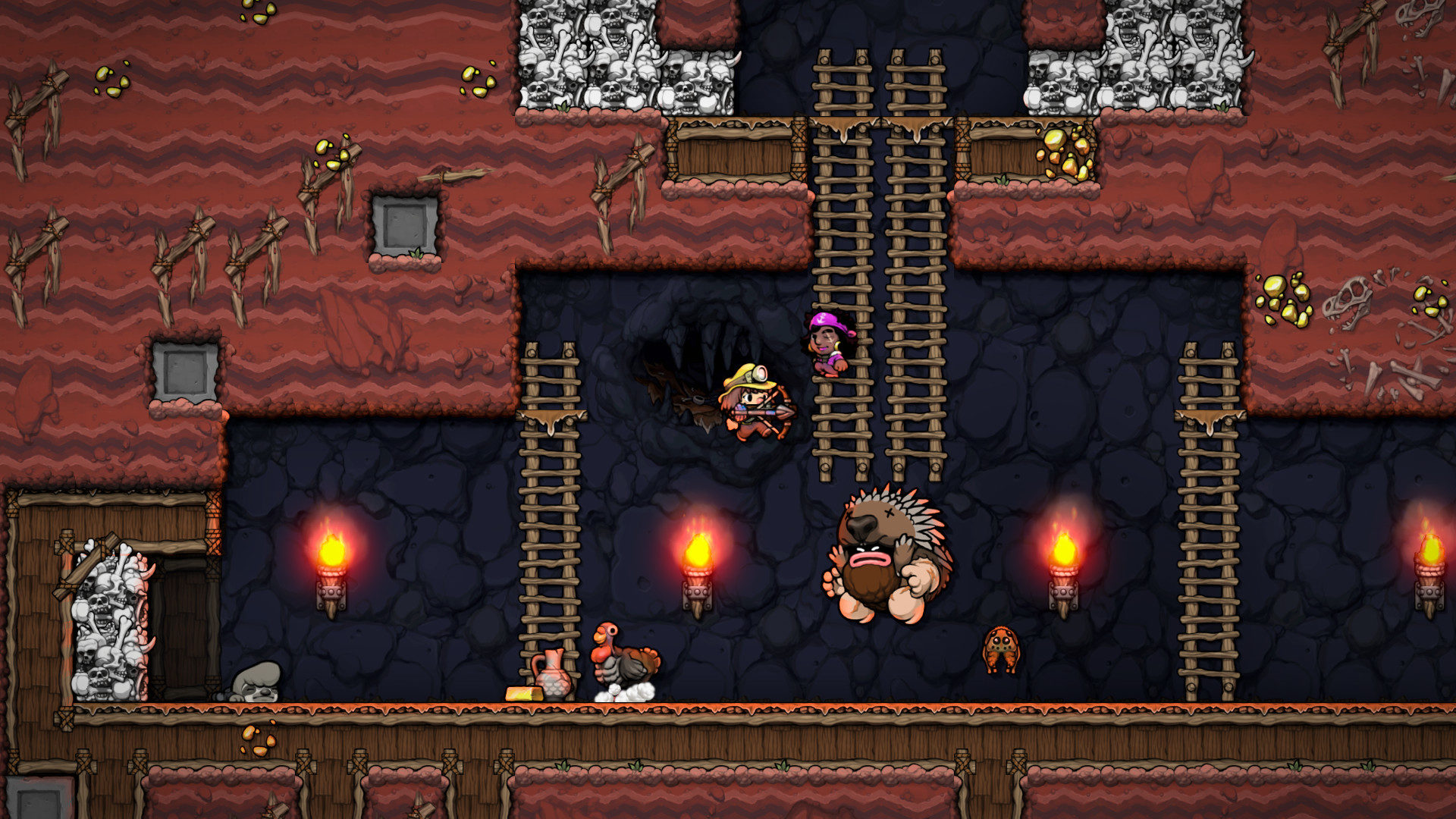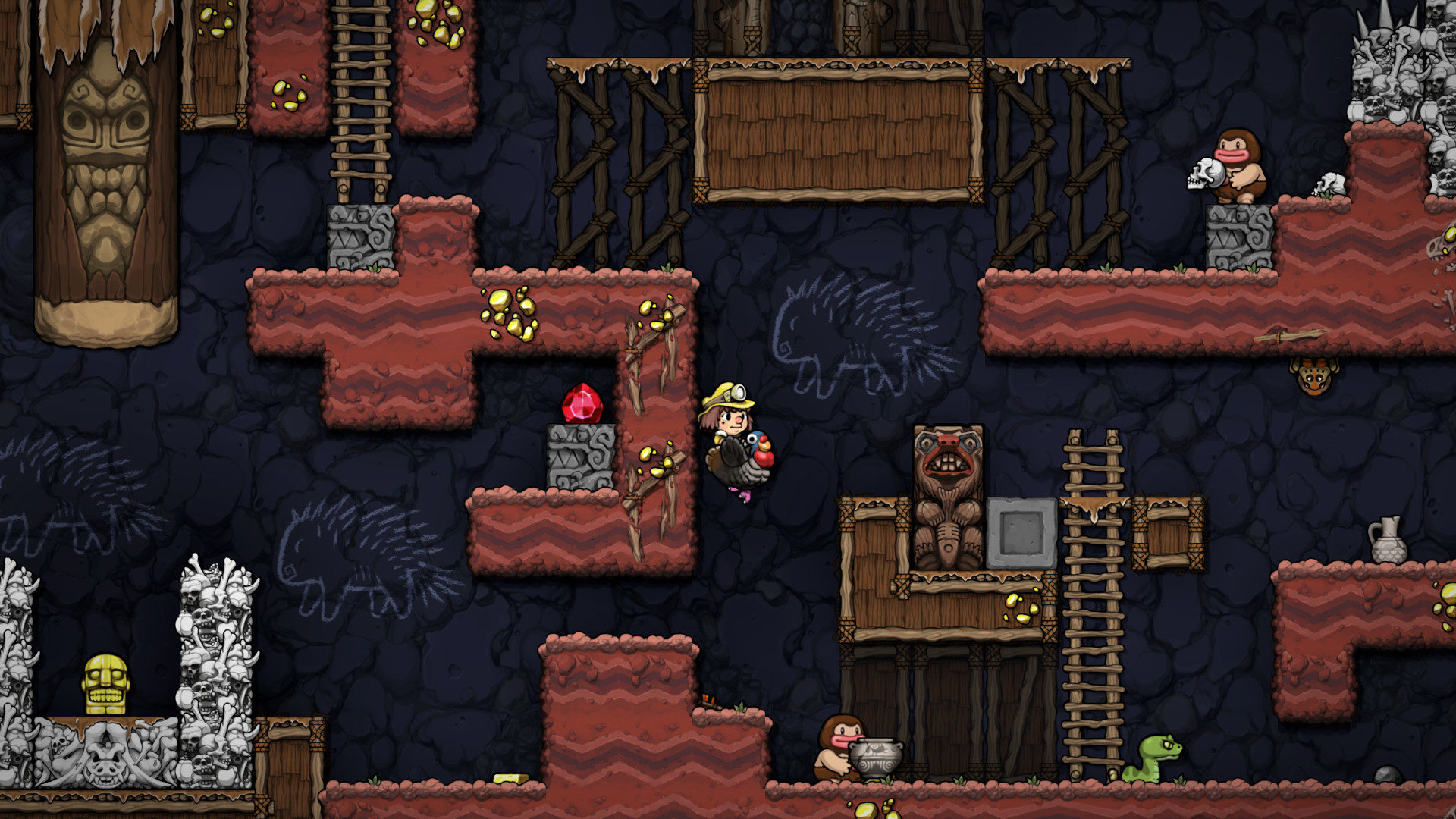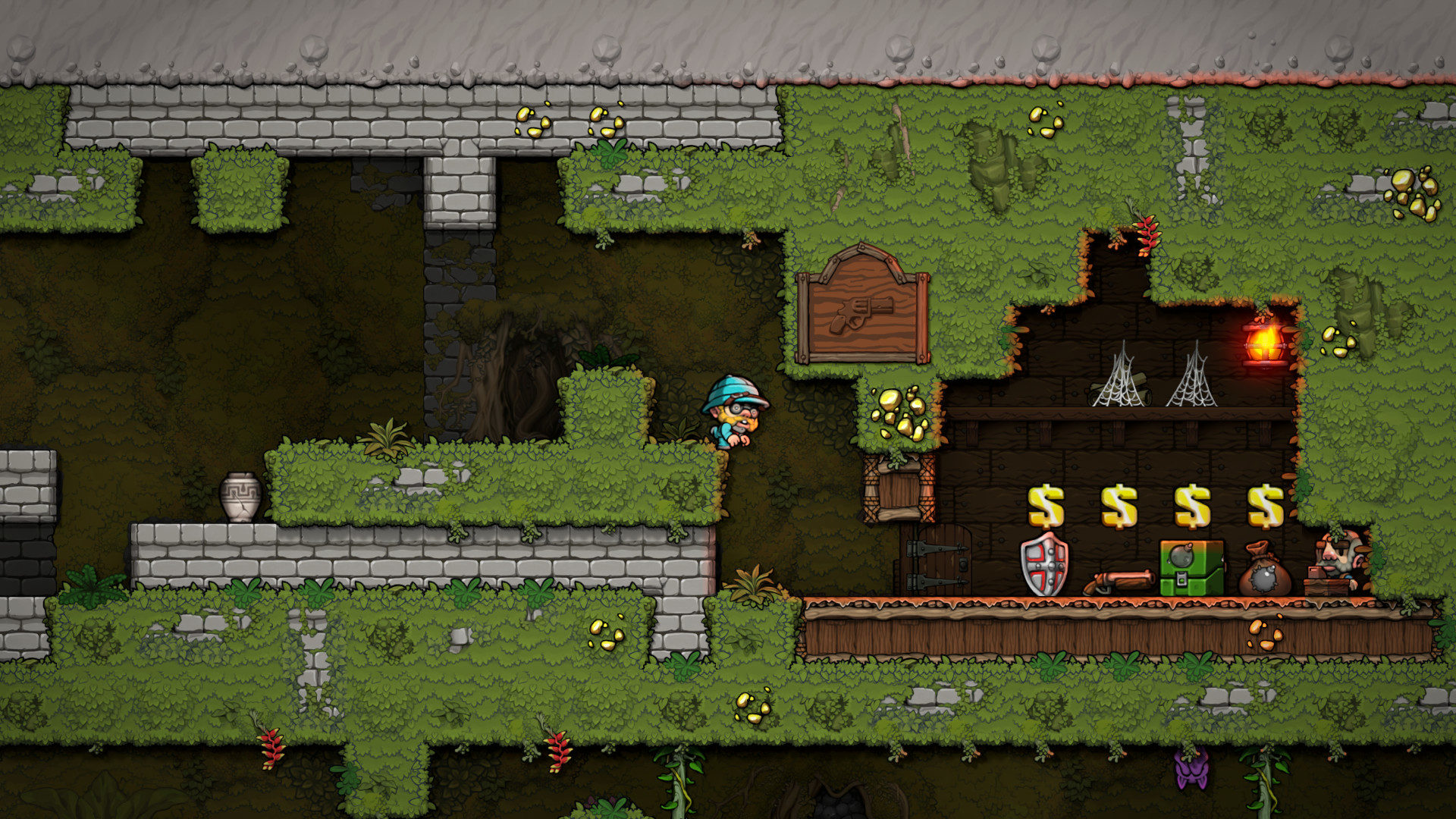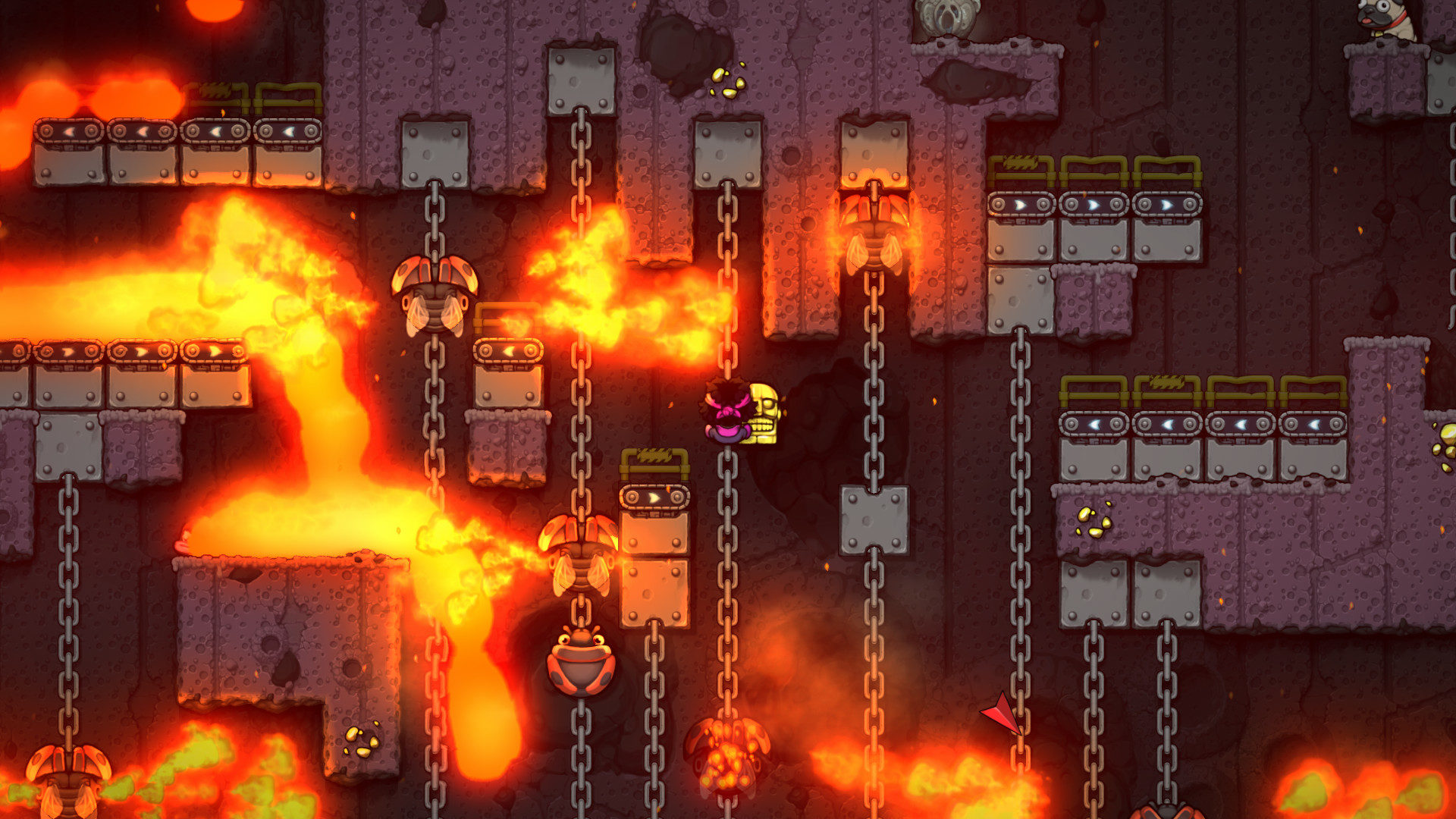Spelunky 2 is a good game because the first Spelunky was an amazing one.
But in the 12 years since Spelunky became an open-source indie darling and in the 8 years since it showed up on consoles and became a full-blown cult classic, a lot of games like Spelunky have shown up with variations on the “roguelike” genre. Playing Spelunky 2, meanwhile, feels like showing up to a high school reunion, seeing old friends who have gone on to have successful careers and start families, and realizing that you haven’t changed at all.
Maybe my imaginary therapist would say I’m projecting, but Spelunky was just one of those games for me. As someone who has devotedly proselytized the purity of 2D platformers ever since I played Super Mario Bros. when I was 5 years old, Spelunky was it for me in 2012. Back then, I was newly released into the real world after years of lurking in the shadows of academia. Staring the myth of upward mobility in its ugly face, the method of descending in a genre (my favorite childhood genre, mind you) that generally projected ascendence or at least left-to-right, chronological progression made Spelunky feel like a message fully embroiled in symbolism and righteousness. The deeper you go, the more you fail, the closer you get to the truth, and the better you understand.
Fast-forward to 2020, and the mechanics that made Spelunky a borderline spiritual exercise are still present in Spelunky 2—but there’s a lack of the discovery and surprise that made the first one so impactful. I’ve changed, the industry has changed, the world has changed, yet Spelunky has stayed exactly the same.
That’s going to be a Very Good Thing for some players. I’d bet a good amount of Spelunky fans will embrace any opportunity to jump back into the game’s randomly generated yet systemically rich world. The traps and enemies whose programming you loved to exploit and set off a chain reaction of death and mayhem in the first game are all back in Spelunky 2, and they all conspire to create memorable, chaotic, Buster Keatonesque murder moments.

I could list all the things about Spelunky 2 that I love, but I would literally just be describing the original Spelunky. What’s left to discuss, then, are some of the smaller improvements the sequel brings and, more discouragingly, what seem like missed opportunities.
There is a sense of expansiveness in Spelunky 2—well, at least as much expansion as there can be in a game that’s meant to instill claustrophobia. When completing a four-level world, players will have the choice to go to one of two new worlds. This essentially doubles the amount of levels from the first game, which is a “good” thing, and adds more aesthetic variety.
There are also more hidden pathways and secret areas that are “behind” the normal levels, though only a few of these truly impact the way you travel through a level.
Multiplayer has gotten a few new avenues, too. You can play online now, which is a great option, though I haven’t tried it, as Spelunky has always been more of a solitary experience to me. There’s also a competitive multiplayer mode, which is conceptually fun and good for a laugh, but it feels more like a distraction than a feature.
Finally, there are multiple mounts you can find and ride throughout the game. All mounts give you access to a double jump as well as a Yoshi-style extra hit, yet each mount has a different special ability. Turkeys, for example, can flap their wings and fall slowly, giving you time to line up your landing. Lions, on the other hand, can shoot fire out of their mouths, which is obviously useful for killing enemies.

As far as new features and improvements go, that’s about it.
What isn’t new is everything else.
Most notably, Mossmouth’s attitude towards progression hasn’t really changed. Unless you can beat a level three times while bringing Tunnel Girl different items she needs, some of which you might not have on you at a time, you won’t be able to unlock shortcuts. While this felt charming and borderline comical back in 2012, nowadays—when there are roguelikes such as Hades that elegantly weave failure into its narrative and sense of progression—Spelunky 2’s attitude towards players trying to descend further feels dated and unintentionally hostile.
I might be projecting again, but it feels as if the universal praise this attitude towards progression received in the first game has stifled the attitude towards progression in this one. There are so many fun tools in Spelunky 2 that seem nearly impossible to get, let alone experiment with. Sure, getting a jetpack or even a webgun in the first Spelunky might have seemed like a special reward and that was the point, but in Spelunky 2 they just feel like they’re being withheld. That’s not because the game makes them harder to get in the sequel; in fact, it’s because you get them in exactly the same way, by purchasing them or killing the shopkeeper.
Again, this might sound great to players who just want to re-experience the original Spelunky, and good on you if that’s what you’re looking for, because it’s here in Spelunky 2. Creator Derek Yu previously stated that his attitude towards sequels is that they “are extensions of the previous games, so I want fans of Spelunky 1 to jump in and feel like they’re playing a continuation, both storywise and mechanically.” That’s all true, but I would argue that the best sequels also give a new perspective on their predecessors by utilizing new tools to expand our understanding of what those games are.

I will once again default to Super Mario Bros. Would players have been fine with playing another Super Mario game where all the plumber could do was jump and throw fireballs? Maybe, but there’s also a reason why Nintendo of America decided The Lost Levels might not be enough. Instead, think about how much the Super Leaf added to Super Mario Bros. 3. Not only did it change the way Mario could move, but it also drastically impacted Nintendo’s attitude towards level design and the types of enemies that they could throw at the player.
What I’m saying is that there is a fine line between a sequel being an “extension” of the previous game and a sequel being hemmed in by the genius of the original’s design. Spelunky 2 seems firmly planted on the latter side of that line. Instead of letting players experiment with what is already there, Spelunky 2 defaults towards making these items special gifts, and in turn defaults towards rehashing what we’ve already played.
Does this make Spelunky 2 a “bad” game? No. Spelunky 2 is a decidedly good game. The platforming is still tight, the enemy AI and the traps are still hilarious, and the adventurous aesthetic and art design still lend a sense of adorableness to an otherwise completely hostile world. In small bursts, it is as enjoyable as ever.
But judging it as a sequel, it feels stagnant. For a game that’s constantly asking players to take calculated risks, Spelunky 2 is surprisingly risk-averse. In a genre and a medium and a world that’s becoming more overwhelming by the second, you can’t really fault a sequel for sticking with what it knows will work. But if you’re asking me what kind of game I want in 2020, a game that asks you to dive deeper into the darkness without rewarding players for doing so just ain’t it.

|
★★★★☆
Spelunky 2 rests on the laurels of its predecessor, and that’s not necessarily a bad thing. It still retains all of the gameplay mechanics and level design that made the original such a satisfying experience. But as a sequel, Spelunky 2 feels a little too scared to expand its horizons. For a game that’s all about taking risks, Spelunky 2 is surprisingly risk-averse. |
Developer Mossmouth Publisher Mossmouth ESRB T - Teen Release Date 09.15.20 |
| Spelunky 2 is available on PlayStation 4 and PC. Primary version played was for PlayStation 4. Product was provided by Mossmouth for the benefit of this coverage. EGM reviews on a scale of one to five stars. | |

Michael Goroff has written and edited for EGM since 2017. You can follow him on Twitter @gogogoroff.